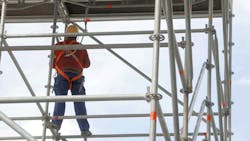OSHA Looks to Construction Enforcement, Regulations, as 2012 Draws to a Close
OSHA has issued a 3-month suspension for its temporary enforcement measures in residential construction. The temporary enforcement measures, now extended through March 15, 2013, include priority, free, on-site compliance assistance, penalty reductions, extended abatement dates, measures to ensure consistency and increased outreach. Fatalities from falls are the number one cause of workplace death in construction.
The agency has been working closely with the industry to assist employers in complying with the new directive. From Oct. 1, 2011 to Sept. 30, 2012, OSHA's On-site Consultation Projects performed more than 3,000 on-site visits, conducted close to 1,100 training sessions and delivered close to 500 presentations related to fall protection in residential construction. OSHA's regional and area offices also conducted more than 1,200 outreach activities on the directive. The agency will continue to work with employers to ensure a clear understanding of, and to facilitate compliance with, the new policy.
OSHA will also continue to develop materials to assist the industry, including a wide variety of educational and training materials to assist employers with compliance, which are available on the Web pages for residential construction and the Fall Prevention Campaign.
In an article written for the January issue of EHS Today magazine, Jim Stanley, a former deputy assistant secretary of labor for OSHA, comments, “In my opinion, OSHA presently does not, nor has it in its history, defined a walking/working surface to include vehicles on which employees must be located to perform their job duties. As an example, OSHA’s construction fall protection standard, 1926.500, specifically excludes vehicles from its definition of a walking/working surface. In 2010, however, 12 percent of fatal falls were from a non-moving vehicle.”
Clearly, says Stanley, OSHA needs to update its standards.
OSHA Updating Construction Standards
OSHA has issued a Request for Information to initiate the fourth phase of its Standards Improvement Project (SIP). The purpose of SIP-IV is to improve and streamline existing OSHA construction standards by removing or revising requirements that are confusing or outdated, or that duplicate or are inconsistent with other standards. Employers, employees and employee representatives as well as industry groups can submit recommendations for revisions to existing construction standards and the rationale for these recommendations. Comments must be submitted by Feb. 4, 2013.
The purpose of the regulatory review is to reduce regulatory burden while maintaining or enhancing workers' safety and health. OSHA published the first SIP rule in 1998. Two additional SIP rulemakings were published in 2005 and 2011. OSHA will review public comments submitted to this notice to determine the need for, and the content of, any subsequent SIP-IV rulemaking.
About the Author

Sandy Smith
Sandy Smith is the former content director of EHS Today, and is currently the EHSQ content & community lead at Intelex Technologies Inc. She has written about occupational safety and health and environmental issues since 1990.
